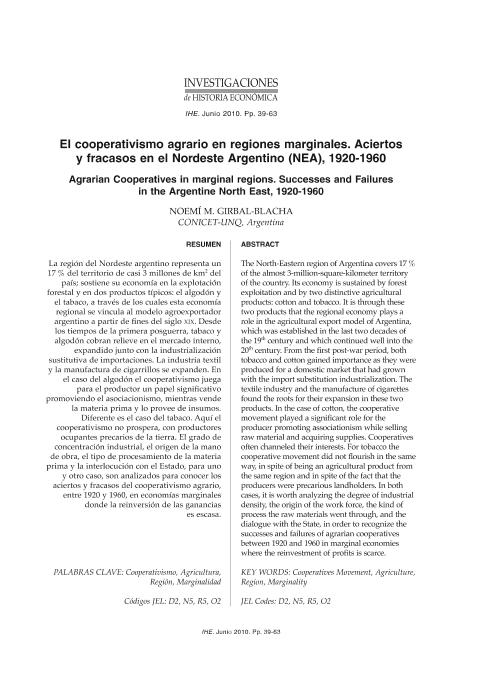Mostrar el registro sencillo del ítem
dc.contributor.author
Girbal, Noemi Maria

dc.date.available
2023-02-27T13:38:07Z
dc.date.issued
2010-06
dc.identifier.citation
Girbal, Noemi Maria; El cooperativismo agrario en regiones marginales: Aciertos y fracasos en el Nordeste Argentino (NEA), 1920-1960; Asociación Española de Historia Económica; Investigaciones de Historia Económica; 6; 17; 6-2010; 39-64
dc.identifier.issn
1698-6989
dc.identifier.uri
http://hdl.handle.net/11336/188944
dc.description.abstract
La región del Nordeste argentino representa un 17% del territorio de casi 3 millones de km2 del país; sostiene su economía en la explotación forestal y en dos productos típicos: el algodón y el tabaco, a través de los cuales esta economía regional se vincula al modelo agroexportador argentino a partir de fines del siglo xix. Desde los tiempos de la primera posguerra, tabaco y algodón cobran relieve en el mercado interno, expandido junto con la industrialización sustitutiva de importaciones. La industria textil y la manufactura de cigarrillos se expanden. En el caso del algodón el cooperativismo juega para el productor un papel significativo promoviendo el asociacionismo, mientras vende la materia prima y lo provee de insumos. Diferente es el caso del tabaco. Aquí el cooperativismo no prospera, con productores ocupantes precarios de la tierra. El grado de concentración industrial, el origen de la mano de obra, el tipo de procesamiento de la materia prima y la interlocución con el Estado, para uno y otro caso, son analizados para conocer los aciertos y fracasos del cooperativismo agrario, entre 1920 y 1960, en economías marginales donde la reinversión de las ganancias es escasa.
dc.description.abstract
The North-Eastern region of Argentina covers 17% of the almost 3-million-square-kilometer territory of the country. Its economy is sustained by forest exploitation and by two distinctive agricultural products: cotton and tobacco. It is through these two products that the regional economy plays a role in the agricultural export model of Argentina, which was established in the last two decades of the 19th century and which continued well into the 20th century. From the first post-war period, both tobacco and cotton gained importance as they were produced for a domestic market that had grown with the import substitution industrialization. The textile industry and the manufacture of cigarettes found the roots for their expansion in these two products. In the case of cotton, the cooperative movement played a significant role for the producer promoting associationism while selling raw material and acquiring supplies. Cooperatives often channeled their interests. For tobacco the cooperative movement did not flourish in the same way, in spite of being an agricultural product from the same region and in spite of the fact that the producers were precarious landholders. In both cases, it is worth analyzing the degree of industrial density, the origin of the work force, the kind of process the raw materials went through, and the dialogue with the State, in order to recognize the successes and failures of agrarian cooperatives between 1920 and 1960 in marginal economies where the reinvestment of profits is scarce.
dc.format
application/pdf
dc.language.iso
spa
dc.publisher
Asociación Española de Historia Económica
dc.rights
info:eu-repo/semantics/openAccess
dc.rights.uri
https://creativecommons.org/licenses/by-nc-nd/2.5/ar/
dc.subject
Cooperativismo (JEL D2)
dc.subject
Agricultura (JEL N5)
dc.subject
Región (JEL R5)
dc.subject
Marginalidad (JEL O2)
dc.subject.classification
Otras Historia y Arqueología

dc.subject.classification
Historia y Arqueología

dc.subject.classification
HUMANIDADES

dc.title
El cooperativismo agrario en regiones marginales: Aciertos y fracasos en el Nordeste Argentino (NEA), 1920-1960
dc.title
Agrarian Cooperatives in marginal regions: Successes and Failures
in the Argentine North East, 1920-1960
dc.type
info:eu-repo/semantics/article
dc.type
info:ar-repo/semantics/artículo
dc.type
info:eu-repo/semantics/publishedVersion
dc.date.updated
2023-02-20T14:13:49Z
dc.journal.volume
6
dc.journal.number
17
dc.journal.pagination
39-64
dc.journal.pais
España

dc.journal.ciudad
Murcia
dc.description.fil
Fil: Girbal, Noemi Maria. Consejo Nacional de Investigaciones Científicas y Técnicas; Argentina. Universidad Nacional de Quilmes. Departamento de Ciencias Sociales. Centro de Estudios de la Argentina Rural; Argentina
dc.journal.title
Investigaciones de Historia Económica
dc.relation.alternativeid
info:eu-repo/semantics/altIdentifier/url/https://recyt.fecyt.es/index.php/IHE/article/view/70249
dc.relation.alternativeid
info:eu-repo/semantics/altIdentifier/doi/https://doi.org/10.1016/S1698-6989(10)70050-3
Archivos asociados
